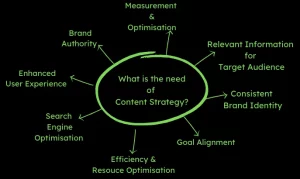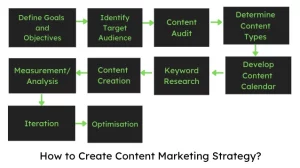What are Content Strategies? Guide to Create a Content Marketing Strategy
Without content, digital marketing is a half ball game. And if you want to market it then you must have some content strategies that you can follow for your growth.
You cannot reach the target audience without marketing. Talking of digital marketing, content is a bigger part without which the businesses will be left to survive in local markets and referral basis. But because we have transcended in leaps and bounds in the digital marketing world, we need to have a strategy.
Today let us explore more about content strategies and how to create marketing content strategies only on word of mouth publicity.
What is Strategic Content Marketing?
Strategic content marketing is an approach that involves the creation and distribution of valuable, relevant, and consistent content to attract, engage, and retain a clearly defined target audience.
Beyond mere advertising or promotional messages, it provides valuable information, insights, and entertainment that align with the audience’s interests and needs.
Here’s a detailed explanation of strategic content marketing:
Audience-Centric Approach:
Strategic content marketing starts by understanding the target audience’s demographics, preferences, behaviours, and pain points. Marketers gain insights into their audience’s motivations and interests by conducting research and developing buyer personas.
Valuable and Relevant Content:
The core of strategic content marketing is creating high-quality content that provides value to the audience. This content can take various forms, including blog articles, videos, podcasts, infographics, ebooks, and social media posts. It addresses the audience’s challenges, answers their questions, and offers solutions or insights that are relevant to their lives.
Storytelling and Brand Narrative:
Strategic content marketing often incorporates storytelling techniques to engage the audience emotionally. By telling compelling stories that align with the brand’s values, mission, and offerings, marketers can build a deeper connection with their audience and create brand affinity.
Channel Selection and Distribution:
Strategic content marketing involves selecting the appropriate channels to reach the target audience effectively. This may include a combination of owned channels (such as the brand’s website, blog, or social media profiles) and earned or paid channels (such as guest blogging, influencer collaborations, or content syndication). Distribution strategies ensure the content reaches the right audience at the right time.
SEO and Search Visibility:
Strategic content marketing also incorporates search engine optimization (SEO) techniques to improve the visibility and discoverability of the content. Marketers can enhance their content’s search rankings and attract organic traffic by optimising content for relevant keywords, following best practices for on-page SEO, and building backlinks.
Measurement and Optimization:
An important aspect of strategic content marketing is measuring the performance and impact of the content. Marketers can gain insights into what resonates with their audience and optimise their content strategies by analysing metrics such as website traffic, engagement rates, social media shares, and conversion rates.
Relationship Building and Conversion:
Strategic content marketing aims to nurture relationships with the audience over time. By consistently providing value and building trust, it establishes the brand as a reliable resource and increases the likelihood of conversion. This may involve lead generation tactics, email marketing, and personalised content experiences.
Continuous Iteration and Improvement:
Strategic content marketing is an iterative process that requires continuous monitoring, analysis, and refinement. By staying updated with industry trends, audience feedback, and data insights, marketers can adapt their content strategies, experiment with new formats, and improve their overall approach.
Read: How to Create Comprehensive UX Strategy?
What is the Need of Content Strategy?
Content strategies are essential for several reasons:
Deliver Relevant Information:
A well-defined content strategy ensures that the content created aligns with the target audience’s needs, interests, and preferences. It helps to deliver relevant and valuable information, addressing their challenges and providing solutions.
Consistency and Cohesion:
Content strategies provides a framework for maintaining consistency and cohesion across all content assets. It establishes guidelines for the tone of voice, messaging, and visual elements, ensuring that the brand’s identity is consistently represented across various channels.
Goal Alignment:
A content strategy helps align content creation efforts with the organisation’s broader goals. It ensures that the content supports specific business objectives, whether brand awareness, lead generation, customer engagement, or thought leadership.
Efficiency and Resource Optimization:
With a content strategy, resources such as time, budget, and personnel can be allocated more effectively. It helps prioritise content initiatives, identify content gaps, and optimise production processes, resulting in efficient and cost-effective content creation.
Search Engine Optimization (SEO):
Content strategy improves search engine rankings and increases organic visibility. By incorporating SEO best practices into content creation, such as keyword research, on-page optimization, and content promotion, the chances of attracting organic traffic and reaching a wider audience are enhanced.
Enhanced User Experience:
A content strategy that delivers a positive user experience by providing valuable, informative, and engaging content. It ensures the content is well-structured, easy to navigate, and accessible across different devices, enhancing user satisfaction and driving repeat visits.
Brand Authority and Thought Leadership:
A strong content strategy helps establish the brand as an authority in its industry or niche. By consistently creating and sharing high-quality content that demonstrates expertise, insights, and thought leadership, the brand can build trust, credibility, and loyalty among its target audience.
Measurement and Optimization:
Content strategy allows for better measurement and optimization of content performance. By defining key performance indicators (KPIs) and establishing metrics for success, it becomes possible to track and analyse the impact of content efforts. This data-driven approach enables the refinement and optimization of future content strategies for better results.
How to Create a Content Marketing Strategy?
A successful content marketing strategy requires ongoing effort, adaptability, and a commitment to creating valuable content that resonates with your audience.
Do you remember how Red Bull started pitching its product?
Their strategy revolves around creating and distributing high-energy, adrenaline-filled content that resonates with their target audience of extreme sports enthusiasts.
Through their Red Bull Media House, they produce captivating videos, articles, and events that promote their brand and inspire and engage their audience, building a strong community of loyal fans.

If you want to spell the audience with a flawless content marketing strategy, read the steps to build one for your brand.
Steps for Creating a Content Marketing Strategy

Creating a content marketing strategy involves several key steps.
Here’s a comprehensive guide on how to create an effective content marketing strategy:
Define Goals and Objectives:
Start by identifying your content marketing goals. What do you want to achieve with your content? Examples include increasing brand awareness, generating leads, driving website traffic, or establishing thought leadership. Set specific, measurable, attainable, relevant, and time-bound (SMART) objectives.
Identify Target Audience:
Gain a deep understanding of your target audience. Conduct market research, create buyer personas, and analyse audience demographics, interests, pain points, and behaviours. This will help you create content that resonates with your audience’s needs and interests.
Conduct Content Audit:
Assess your existing content assets to identify gaps and opportunities. Analyse the performance of your current content in terms of engagement, traffic, and conversions. Determine which content types and topics have been successful and identify areas for improvement.
Determine Content Types and Channels:
Decide on the types of content that align with your audience’s preferences and objectives. This could include blog posts, videos, infographics, podcasts, case studies, or whitepapers. Identify the most suitable channels to distribute and promote your content, such as your website, blog, social media platforms, email newsletters, or industry publications.
Develop a Content Calendar:
Create a content plan calendar that outlines the topics, formats, and distribution schedule. Align your content plan with your marketing goals and ensure a mix of content that educates, entertains, inspires, and informs your audience. Plan for consistency and allocate resources effectively.
Keyword Research and SEO:
Conduct keyword research to identify relevant keywords and phrases that align with your content topics and audience search intent. Optimise your content for search engines by incorporating keywords naturally into your content, titles, meta tags, and URLs. Aim to improve search rankings and increase organic visibility.
Content Creation and Distribution:
Produce high-quality, engaging content that provides value to your audience. Ensure your content is well-researched, well-written, and visually appealing. To reach your target audience, develop a distribution strategy to promote your content across relevant channels using social media, email marketing, influencer outreach, and other distribution methods.
Measurement and Analysis:
Establish metrics to track the performance of your content marketing efforts. This could include metrics such as website traffic, engagement rates, social media shares, conversions, or ROI. Use analytics tools to monitor and analyse the data, identify trends, and make data-driven decisions for optimising your content strategy.
Iteration and Optimization:
Continuously evaluate the performance of your content marketing strategy and make necessary adjustments. Test different content formats, distribution channels, and messaging to optimise results. Stay updated with industry trends and audience feedback to keep your content strategy relevant and effective.
Brand Example of Content Marketing Strategy
AirBnB stands for Air Mattress Bed and Breakfast. The brand’s content marketing strategy focuses on storytelling and travel inspiration.
Here’s a brief overview:
Airbnb Magazine:

Airbnb publishes a print and online magazine that features captivating stories, travel guides, and insider tips. The content highlights unique destinations, accommodations, and local experiences, inspiring travellers to explore new places and book stays through Airbnb.
Neighborhood Guides:

Airbnb offers comprehensive neighbourhood guides for popular travel destinations. These guides provide insights into local culture, attractions, and hidden gems, helping travellers make informed decisions about their stay and immerse themselves in the community.
Experiences:

Airbnb promotes its “Experiences” platform, where local hosts offer unique activities and guided tours. Through storytelling, videos, and photos, Airbnb showcases diverse experiences, encouraging travellers to book and participate in authentic, immersive activities.
Social Media and Influencer Marketing:
Airbnb leverages social media platforms to share visually appealing and engaging content, including user-generated photos and videos. They collaborate with influencers and content creators to amplify their brand message and reach wider audiences.
Airbnb Blog

The Airbnb blog features a variety of articles, city guides, and travel tips. They cover responsible travel, sustainability, and cultural experiences, providing valuable information to inspire and educate their audience.
Content Partnerships

Airbnb collaborates with publishers, travel bloggers, and influencers to create and distribute content that aligns with their brand values. By partnering with reputable sources, they expand their reach and tap into new audiences.
Conclusion
A well-crafted content strategy is a powerful tool for brands to connect with their audience, drive engagement, and achieve business goals. By understanding the target audience, creating valuable content, leveraging storytelling techniques, and measuring performance, brands can build trust, establish authority, and drive meaningful results.
Need assistance in developing your content strategy? Connect with Noboru at hello[at]noboruworld.com for expert guidance and support in creating a compelling content strategy tailored to your brand’s requirements.
FAQ
What is content strategy?
Content strategy is a plan that outlines content creation, publication, and management to achieve specific business goals. It involves understanding the target audience, defining content objectives, determining content types and formats, and establishing content creation, distribution, and measurement guidelines.
Why is content strategy important?
Content strategy is important because it ensures that the right content is created and delivered to the right audience at the right time. It helps build brand authority, engage customers, and drive conversions. A well-defined content strategy also maximises the efficiency and effectiveness of content creation efforts, leading to better ROI and long-term success.
How does content strategy align with SEO?
Content strategy and SEO are closely interconnected. Content strategy helps identify relevant keywords and topics that align with user intent and search queries. By creating high-quality, keyword-optimized content, businesses can improve search engine rankings, increase organic traffic, and enhance user engagement. A well-executed content strategy can also attract inbound links and social shares, boosting SEO performance.
How often should a content strategy be reviewed and updated?
The frequency of reviewing and updating a content strategy depends on factors such as industry trends, business goals, and content performance. It is recommended to review the content strategy at least annually or more frequently if there are significant changes in the market, audience needs, or business objectives. Regular monitoring of content metrics and user feedback can help identify improvement areas and guide strategy updates.
Also Read – Jumpstart your content marketing game




